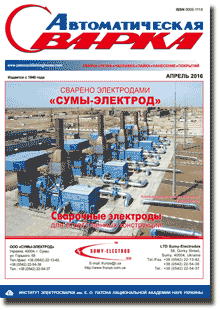| 2016 №04 (03) |
DOI of Article 10.15407/as2016.04.04 |
2016 №04 (05) |

Avtomaticheskaya Svarka (Automatic Welding), #4, 2016, pp. 42-46
Properties of high-alloyed metal deposited using electroslag two-strip method
A.A. Babinets
E.O. Paton Electric Welding Institute, NASU 11 Kazimir Malevich Str., 03680, Kiev, Ukraine. E-mail: office@paton.kiev.ua
Abstract
During surfacing of corrosion-resistant layer on the parts of power and chemical equipment it is often necessary to obtain a specified chemical composition and properties of deposited metal already in the first layer. The influence of current, voltage and deposition rate as well as the sizes of gap between the strips on the stability of electroslag process, geometric dimensions of deposited beads and volume of base metal in the deposited metal were investigated. The range of surfacing modes using two strips of stainless steel of 0.5x60 mm section was determined, in which a stable electroslag process with a good formation of deposited metal and minimum penetration of the base metal in the range of 7–9 %, i.e. Is = 1400–1500 A, Us = 32–33 V and νd = 14–17 m/h; 16 mm gap between the strips, is observed. The mechanical properties of metal, deposited at these modes using strips ESAB OK Band 309LNb ESW and Sv-08Kh19N10G2B under flux ESAB OK 10.10, are at a sufficiently high level and meet the requirements specified to them. The obtained results may be used in selection or development of materials and technologies of anticorrosive surfacing of parts of power and chemical equipment. 11 Ref., 4 Tables, 5 Figures.
Keywords: electroslag surfacing, deposited metal, electrode strip, bimetal, corrosion-resistant layer, surfacing modes, mechanical properties
Received: 21.01.2016
Published: 02.06.2016
References
1. Kravtsov, T.G. (1978) Electric arc surfacing by electrode strip. Moscow: Mashinostroenie.
2. Ryabtsev, I.A. (2005) High-efficiency wide-layer surfacing using electrode wires and strips (Review). The Paton Welding J., 6, 31–35.
3. Ivanov, V.P., Ivashchenko, V.Yu. (2011) Influence of hardfacing technology and heat treatment on structure and properties of metal deposited on carbon steel by LN-02Kh25N22AG4M2 strip electrode. Ibid., 8, 7–9.
4. Fetisov, G.P., Karpman, M.G. (2001) Materials science and technology of metals. Moscow: Vysshaya Shkola.
5. Frumin, I.I., Kalensky, V.K., Panchishin, Yu.A. et al. (1977) Development of process and examination of some technological specifics of electroslag surfacing by strips. In: Theoretical and technological principles of surfacing. New processes of mechanized surfacing, 83–88. Kiev: PWI.
6. Kalensky, V.K., Panchishin, Yu.A., Shekhteri, S.Ya. et al. (1980) Application of electroslag surfacing using sintered strips for manufacturing of double-layer sheet billets. In: Theoretical and technological principles of surfacing. Properties and tests of deposited metal, 89–92. Kiev: PWI.
7. Ignatov, V.A., Murzin, V.V., Rokhlin, E.A. et al. (1980) Study of process of electroslag anticorrosive surfacing by two-strip electrodes. In: Ibid., 101–106.
8. Buga, V.M. (1978) Development of flux and investigation of deposited metal properties with regard to single-layer surfacing of nickel-chrome alloy. In: Theoretical and technological principles of surfacing. Surfacing consumables, 95–98. Kiev: PWI.
9. Kalensky, V.K., Panchishin, Yu.A. (1985) On efficiency of anticorrosive electrode strip surfacing. In: Surfacing. Experience and efficiency of application, 35–40. Kiev: PWI.
10. Production of equipment and consumables for welding and cutting. http://www.esab.com/
11. (1974) Technology of electric fusion welding of metals and alloys: Monograph. Ed. by B.E. Paton. Moscow: Mashinostroenie.
The cost of subscription/purchase order journals or individual articles
| Journal/Currency | Annual Set | 1 issue printed |
1 issue |
one article |
| TPWJ/USD | 384 $ | 32 $ | 26 $ | 13 $ |
| TPWJ/EUR | 348 € | 29 € | 24 € | 12 € |
| TPWJ/UAH | 7200 UAH | 600 UAH | 600 UAH | 280 UAH |
| AS/UAH | 1800 UAH | 300 UAH | 300 UAH | 150 UAH |
| AS/USD | 192 $ | 32 $ | 26 $ | 13 $ |
| AS/EUR | 180 € | 30 € | 25 € | 12 € |
| SEM/UAH | 1200 UAH | 300 UAH | 300 UAH | 150 UAH |
| SEM/USD | 128 $ | 32 $ | 26 $ | 13 $ |
| SEM/EUR | 120 € | 30 € | 25 € | 12 € |
| TDNK/UAH | 1200 UAH | 300 UAH | 300 UAH | 150 UAH |
| TDNK/USD | 128 $ | 32 $ | 26 $ | 13 $ |
| TDNK/EUR | 120 € | 30 € | 25 € | 15 € |
AS = «Automatic Welding» - 6 issues per year;
TPWJ = «PATON WELDING JOURNAL» - 12 issues per year;
SEM = «Electrometallurgy Today» - 4 issues per year;
TDNK = «Technical Diagnostics and Non-Destructive Testing» - 4 issues per year.





